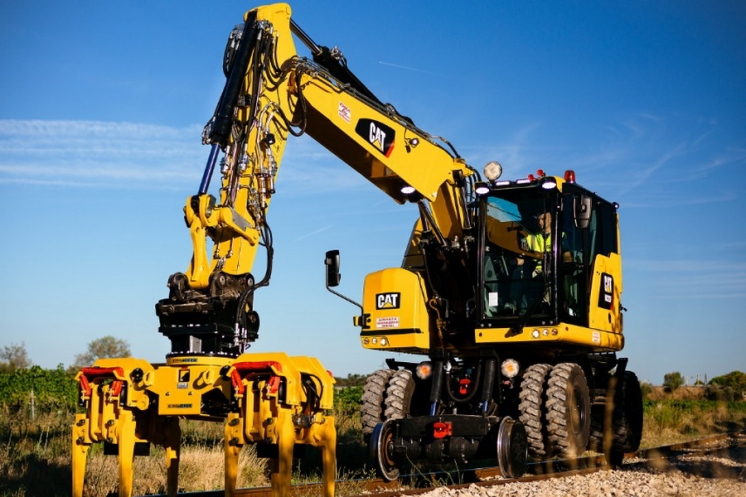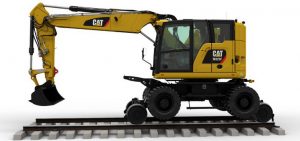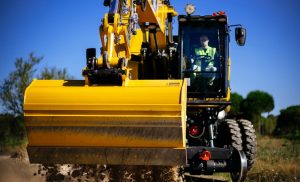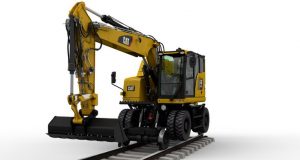A little excavator, a little locomotive – two-way wheel excavator Cat M323F

Caterpillar enters a new two-way model, the Cat M323F. You can read more about what the new machine is like and what is different here due to track operation.
For many of us, the first opportunity to see the brand new Cat M323F appeared at last year’s BAUMA trade fair. I was already fascinated by this remarkable machine and I was looking forward to the opportunity to learn more details.
Special machine
At first glance, it is clear that the Cat M323F is a special machine. This is not an ordinary wheeled excavator to which someone has bolted the wheels of a locomotive, this is a machine completely built for railway operation. Therefore, the basis is not one, but two machines. Chassis, resp. its base comes from the M318 excavator, the superstructure then from the smaller M316 type. And both are modified.

Why were these basics chosen for a two-way machine? Are they simply in stock? Not at all, the developers built a machine that will be stable thanks to a proper base, but at the same time will be compact. In the case of railways, millimetres also play a role. The train has nowhere to go, its path is fixed. Even a minimal overlap in the running profile of the neighboring track means that both tracks are out of service at once. However, if you have a Cat M323F, you can rest easy. The compact superstructure does not endanger the adjacent track, the trains do not have to stop and the work can continue.
Railway regulations, for some sections of the track, require the presence of the so-called pilot, more official in terms of language, a person familiar with the track. And it is for this second ‘driver’ that the second cabin is intended. At the same time, the developers of Caterpillar humorously managed to locate it so that it would not interfere with the maintenance of the machine, it is pass-through. There is still perfect access to the service points on the body.
Chassis advantage
The designers of the Cat M323F decided to use the method of power transmission on the rail, also known as type 9A. The whole machine thus rises above the tracks and the railway underframe had to be retrofitted with separate engines. This solution has several undeniable advantages. Any of you have ever tried to drive a car on the tram tracks in the city center, you know. In short, tires are not built to transfer power to smooth metal. Once it rains, the tire will just roll helplessly.
The Cat M323F is a machine with all four rail wheels directly driven. As a result, it can pull up to four wagons and has no trouble starting even in bad weather. At the same time, raising the tires above the tracks does not interfere with the train’s running profile. This is an important thing, modern railways contain a number of sensors that monitor not only the position of trains, but also whether the temperature of their underframes or vibrations do not exceed the limits. These sensors are no obstacle to the Cat M323F.

Electronic system and counterweights
Two-way excavators from all manufacturers face one major problem, and that is stability. Where other machines can prop up on massive underframes, often supplemented by blades and feet, railway machines have only rails underneath, they can’t be supported with anything else.
SMART CONTROL SYSTEM
The electronics constantly monitor the load, the center of gravity, the position of the arm and the rotation of the body, and make sure that the M323F does not exceed its limits. This is called SMART CONTROL SYSTEM. The boundary position here is not an imaginary wall which the machine hits just for not reach a position from which there is no return. Everything works smoothly and comfortably, you can use the machine to the extreme without fear, knowing that it will always stop on time and smoothly as soon as it reaches its limit. For greater reliability and safety, all sensors on the machine are doubled.

Source: Lomy a těžba
